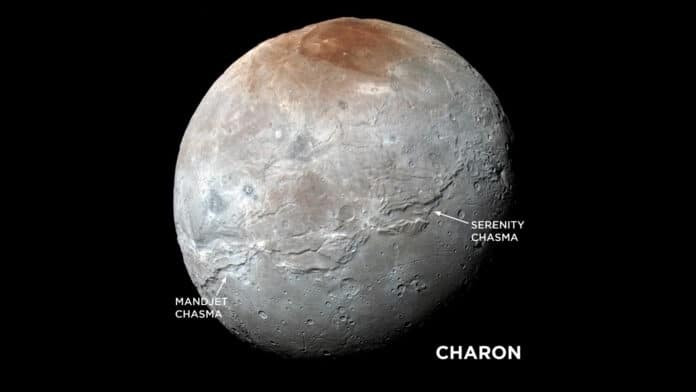A combination of geological interpretations and thermal-orbital evolution models imply that Pluto’s large moon, Charon, had a subsurface water ocean that eventually froze. Ocean freezing generates large tensile stresses in the upper part of the ice shell. It pressurizes the ocean below, perhaps forming Charon’s large canyons and putative cryovolcanic flows.
In a new study, scientists at Southwest Research Institute modeled the formation of fractures within Charon’s ice shell as the ocean underneath it freezes to explore the evolution of Charon’s interior and surface.
Using the data from NASA’s New Horizons spacecraft, which encountered the Pluto-Charon system in 2015, scientists created a model to explore the source of cryovolcanic flows and an obvious belt of fractures on Pluto‘s large moon Charon. The model suggested that when the moon’s internal ocean froze, it may have formed the deep, elongated depressions along its girth but was less likely to lead to cryovolcanoes erupting with ice, water, and other materials in its northern hemisphere.
SwRI’s Dr. Alyssa Rhoden, a specialist in the geophysics of icy satellites, said, “When an internal ocean freezes, it expands, creating large stresses in its icy shell and pressurizing the water below. We suspected this was the source of Charon’s large canyons and cryovolcanic flows.”
The liquid, compressed by the increased volume of the newly formed ice, can be pushed through the fractures to erupt onto the surface when fractures pierce the entire ice shell and tap the deep ocean. The goal of the models was to determine the circumstances that could lead to fractures that completely breach Charon’s icy shell, linking its surface and subsurface water to enable cryovolcanoes derived from the ocean.
The ice shells on Charon, however, were much too thick to be completely cracked by the forces brought on by ocean freezing, according to current models of Charon’s internal evolution.
Another crucial factor is the moment when the ocean freezes. Tidal heating only occurred during the first million years of the solar system because Pluto and Charon’s synchronous and circular orbits stabilized very early.
Rhoden said, “Either Charon’s ice shell was less than 6 miles (10 km) thick when the flows occurred, as opposed to the more than 60 miles or 100 km indicated, or the surface was not directly communicated with the ocean as part of the eruptive process. If Charon’s ice shell had been thin enough to be fully cracked, it would imply substantially more ocean freezing than is indicated by the canyons identified on Charon’s encounter hemisphere.”
These canyons may have been started by cracks in the ice shell along the ridges that make up the global tectonic belt that runs over Charon’s face and divides the moon’s northern and southern geological regions. If additional large extensional features were identified on the hemisphere not imaged by New Horizons, or compositional analysis could prove that Charon’s cryovolcanism originated from the ocean, it would support the idea that its ocean was substantially thicker than expected.
Rhoden said, “Ocean freezing also predicts a sequence of geologic activity, in which ocean-sourced cryovolcanism ceases before strain-created tectonism. A more detailed analysis of Charon’s geologic record could help determine whether such a scenario is viable.”
Journal Reference:
- Alyssa Rose Rhoden, Maxwell L. Rudolph, Michael Manga. The challenges of driving Charon’s cryovolcanism from a freezing ocean. Icarus, 2023; 392: 115391 DOI: 10.1016/j.icarus.2022.115391
